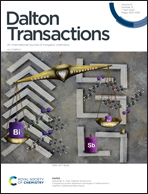A novel optical thermometry strategy based on emission of Tm3+/Yb3+ codoped Na3GdV2O8 phosphors†
Abstract
In the last few years, huge progress has been made in the development of remote optical thermometry strategies, due to their non-contact, high-sensitivity and fast measurement characteristics, which are especially important for various industrial and bio-applications. For these purposes, lanthanide-doped particles seem to be the most promising luminescence thermometers. In this study, Tm3+/Yb3+:Na3GdV2O8 (NGVO) phosphors were prepared using a sol–gel method. Under 980 nm excitation, the upconversion (UC) and down-shifting (DS) emission spectra are composed of two visible emission bands arising from the Tm3+ transitions 1G4 → 3H6 (475 nm) and 1G4 → 3F4 (651 nm), a strong emission at 800 nm (3H4 → 3H6) in the first biological window and emission in the third biological window at 1625 nm (3F4 → 3H6), respectively. Accordingly, the luminescence intensity ratio (LIR) between the Tm3+ LIR1 (800/475) and LIR2 (1625/475) transitions demonstrates excellent relative sensing sensitivity values (4.2% K−1–2% K−1) and low-temperature uncertainties (0.4 K–0.5 K) over a wide temperature sensing range of 300 K to 565 K, which are remarkably better than those of many other luminescence thermometers. This phosphor exhibits strong NIR emission at low excitation density, meaning that it has potential uses in deep tissue imaging, optical signal amplification and other fields. The results indicate that Tm3+/Yb3+:NGVO is an ideal candidate for thermometers and particularly for biological applications.



 Please wait while we load your content...
Please wait while we load your content...